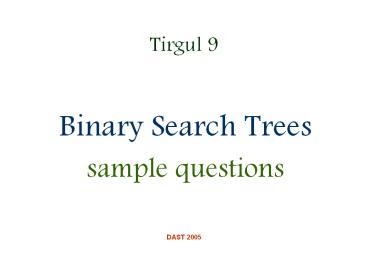Tirgul 9 - PowerPoint PPT Presentation
Title:
Tirgul 9
Description:
... computing the height of a binary search tree (BST), what is its time complexity? ... You are provided with a nearly BST, a binary tree in which for every node, ... – PowerPoint PPT presentation
Number of Views:32
Avg rating:3.0/5.0
Title: Tirgul 9
1
Tirgul 9
- Binary Search Trees
- sample questions
2
- Q. Write a pseudo code for computing the height
of a binary search tree (BST), what is its time
complexity? - A. The height of a binary tree is the maximum
between the height of its children 1. We can
write a simple recursive algorithm for
calculating the height - int height(node)
- if (node null)
- return -1
- return (1 max(height(node.left),
height(node.right))) - The algorithm visits all of the tree nodes
- ? its time complexity is O(n)
3
- Q. You are provided with a nearly BST, a binary
tree in which for every node, either the key of
its left child is smaller than its key and the
key of its right child is bigger, or vice versa.
Write a pseudo code for fixing the tree, what is
its complexity? - A. The solution is very simple, we should check
each node and swap its children if necessary, pay
attention that fixing (or not fixing) a node
doesnt say we shouldnt fix its children. - void fix(node)
- // should check for nulls
- if (node.left.key gt node.right.key)
- swap(node.left,node.right)
- fix(node.left)
- fix(node.right)
- The algorithm visits all of the tree nodes
- ? its time complexity is O(n)
4
- Q. Your colleague tells you he has found a
remarkable BST property Suppose that the search
for key k in a binary search tree ends up in a
leaf. Consider three sets A - the keys to the
left of the search path B - the keys on the
search path and C - the keys to the right
of the search path. He claims that any three keys
must satisfy
a lt b lt c. Is the claim true? - A. No
3
8
5
- Q. Write an algorithm for building a sorted
circular doubly linked list containing the
elements of a BST, what is its complexity? - A. We should iterate through all the tree nodes,
starting with the minimum and moving to the
successor and add them to the list (remembering
to link the last node to the first one) - --- no pseudo code ---
- Traversing through all the nodes takes O(n)
(previous tirgul). Adding n elements to the list
takes O(n) as well - ? the total time complexity is therefore O(n)
- One drawback
- We need an extra O(n) space complexity (for the
list) - can we avoid the extra space?
6
- Q. Write an algorithm for the same purpose
without using the extra space (at the same time
complexity) - A. We exploit the fact that the keys of all the
members to the left of a node are smaller than
that of the node while all those to its right are
larger. - Intuitively, we would like to convert the left
subtree into a list, convert the right subtree
into a list and concatenate the lists LEFT,
node, RIGHT. - The algorithm is recursive and does exactly so
It uses the tree nodes
pointers (NO EXTRA SPACE!). In the result list,
left means previous while right means next
The algorithm performs a constant amount of work
for each node and its time complexity is
therefore linear
7
- List TreeToList(root)
- if (root null)
- return null
- List LEFT TreeToList(root.left)
- List RIGHT TreeToList(root.right)
- List ROOT makeList(root)
- return concatenate(LEFT, ROOT, RIGHT)
- makeList - takes a single tree node and
builds a circular doubly linked list (containing
one element) of it.
8
- concatenate - takes three circular doubly
linked lists and concatenates them into one list
(assume it can handle null lists) - List concatenate(LEFT, ROOT, RIGHT)
- // should handle null lists
- LEFT.left.right ROOT
- ROOT.left LEFT.left
- ROOT.right RIGHT
- RIGHT.left.right LEFT
- LEFT.left RIGHT.left
- RIGHT.left ROOT
- return LEFT
9
- Concatenate example
LEFT
ROOT
RIGHT
LEFT.left.right ROOT
LEFT
ROOT
RIGHT
10
ROOT.left LEFT.left
LEFT
ROOT
RIGHT
ROOT.right RIGHT
LEFT
ROOT
RIGHT
11
RIGHT.left.right LEFT
LEFT
ROOT
RIGHT
LEFT.left RIGHT.left
LEFT
ROOT
RIGHT
12
RIGHT.left ROOT
LEFT
ROOT
RIGHT































